Advice for Applying and Wearing Your Compression Sleeve
This leaflet explains why you need to wear compression sleeves and advice on how to apply and care for them.
If you would like additional information about compression garments, please speak to one of the lymphoedema nurses. They will be more than happy to help.
Introduction
If you have lymphoedema (swelling) in your arm and /or hand, you may be fitted into a compression garment (sleeve and/or glove). Compression garments aim to reduce any existing swelling and prevent further swelling from developing by encouraging lymph fluid to drain away from the affected arm. The garments provide a firm resistance which forces the lymph vessels to be squeezed by the muscles during movement and activity. Your lymphoedema nurse will assess which type of garment is best for you.
Application
The garment is normally worn all day and removed at bedtime, unless advised otherwise by your lymphoedema nurse. Put them on as soon as possible in the morning when there is less swelling. It is important to wear them for any form of exercise.
Sharp fingernails, rings and bracelets can damage the fabric on the garment. Remove any jewellery before you apply your garment. It can help to use rubber gloves when applying the garment.
Ensure your arm is clean and dry before applying the garment. Do not moisturise your arm prior to applying the garment. Moisturising cream should be applied to the arm at bedtime when the garment is removed.
Applying an arm sleeve WITHOUT handpiece
- Fold the sleeve down, inside out, to approximately halfway.
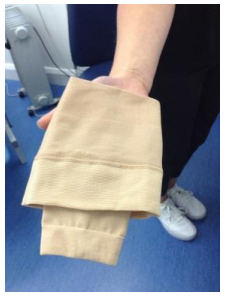
- Pull the garment over the hand to sit at the wrist.
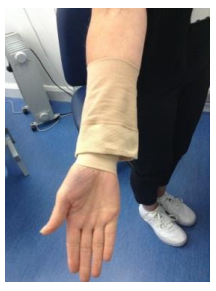
- Gradually ease the garment up the arm in stages, a few centimetres at a time, placing it where it needs to finish (top of arm).
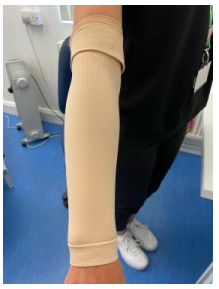
- Run the palm of your hand up and down the arm to smooth out any creases/wrinkles.
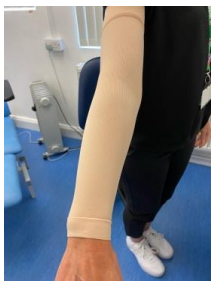
Applying an arm sleeve WITH handpiece
- Fold the sleeve down, inside out, to the wrist.
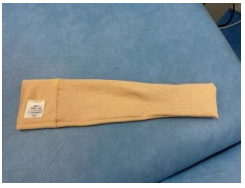
- Slip your hand into the handpiece so that it fits comfortably around the thumb and palm.
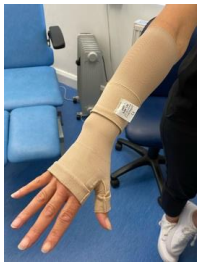
- Gently ease the garment up to the elbow and then to the top of the arm, a few centimetres at a time.
- Run the palm of your hand up and down the arm to smooth out any creases/wrinkles.
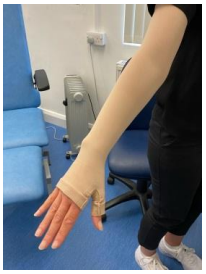
General care
You will normally be provided with two garments. Your lymphoedema nurse will supply the first garment, and then you may be asked to obtain further supplies through your GP if they are available on prescription. Your Nurse will explain the process to you. You will normally need two new garments every six months.
- It is recommended to wash the garments daily as this not only removes any dead skin cells and bacteria from the fabric, but also returns the garment to its original shape
- Hand wash using gentle soap powder or machine wash (maximum 40°C). Do not use fabric conditioner. A laundry net can provide additional protection
- Rinse well in clean, warm water if hand washing, or spin in washing machine. Roll up in a towel to remove excess water
- Dry flat away from direct heat. Do not tumble dry
- Do not turn the top of the garment over if it seems too long, as this will put too much pressure on the top of your arm; speak to your lymphoedema nurse if this occurs.
Contact your lymphoedema nurse if:
- Your garment does not fit well. If your weight changes, the garment may become too loose or too tight
- It is very painful to wear your garment, or there is a sudden change in sensation (numbness/tingling) or a change in colour in your fingers
- You develop swelling in areas not covered by the garment, such as fingers or hand; you may need a different style of garment
- You develop an infection in your arm as your garment may be too painful to wear. Remove the garment until the infection has settled.
- For a useful video on applying your arm sleeve please view the following link on YouTube: https://www.youtube.com/watch?v=z0jA-w_aPNI
Contact numbers
We hope that you have found this information useful. If you have any questions or are worried about anything, please speak to the following Dorset County Hospital staff:
Lymphoedema nurses: 01305 255370
Useful websites
Breast Cancer Care: www.breastcancercare.org.uk
Lymphoedema Support Network: www.lymphoedema.org
About this leaflet
Author: Dawn Johnston, Lymphoedema Nurse
Written: July 2022
Approved: August 2022
Review Date: August 2025
Edition: v1
If you have feedback regarding the accuracy of the information contained in this leaflet, or if you would like a list of references used to develop this leaflet, please email patientinformation.leaflets@dchft.nhs.uk
Print leaflet